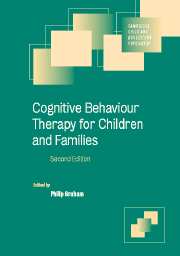Book contents
- Frontmatter
- Contents
- List of contributors
- 1 Introduction
- Part I Developmental cognitive theory and clinical practice
- Part II Engagement and assessment
- Part III Client groups
- Part IV Applications in psychosocial adversity
- Part V Applications in specific child and adolescent psychiatric disorders
- 12 Behavioural approaches to eating and sleeping problems in young children
- 13 Conduct disorders in young children
- 14 Attention deficit hyperactivity disorder
- 15 Children with developmental disabilities and their parents
- 16 Depressive disorders
- 17 Cognitive behavioural psychotherapy for obsessive compulsive disorders
- 18 Anxiety disorders
- 19 School refusal
- 20 Post-traumatic stress disorders
- 21 Disorders of eating control
- 22 Chronic fatigue syndrome
- 23 Children's interpersonal problems
- 24 Pain in childhood
- 25 Conduct disorders in adolescence
- 26 Drug and alcohol abuse
- Part VI CBT applications in preventive interventions
- Index
- References
26 - Drug and alcohol abuse
Published online by Cambridge University Press: 21 August 2009
- Frontmatter
- Contents
- List of contributors
- 1 Introduction
- Part I Developmental cognitive theory and clinical practice
- Part II Engagement and assessment
- Part III Client groups
- Part IV Applications in psychosocial adversity
- Part V Applications in specific child and adolescent psychiatric disorders
- 12 Behavioural approaches to eating and sleeping problems in young children
- 13 Conduct disorders in young children
- 14 Attention deficit hyperactivity disorder
- 15 Children with developmental disabilities and their parents
- 16 Depressive disorders
- 17 Cognitive behavioural psychotherapy for obsessive compulsive disorders
- 18 Anxiety disorders
- 19 School refusal
- 20 Post-traumatic stress disorders
- 21 Disorders of eating control
- 22 Chronic fatigue syndrome
- 23 Children's interpersonal problems
- 24 Pain in childhood
- 25 Conduct disorders in adolescence
- 26 Drug and alcohol abuse
- Part VI CBT applications in preventive interventions
- Index
- References
Summary
Introduction
There has been increasing interest in the problem of adolescent substance use and abuse over the last decade. This arises from the changing patterns of use, greater recognition of the problem, the complexity and heterogeneity of these young populations, the increased risk of later comorbid problems and the associated impairments in many domains of functioning. Significant substance use/abuse is associated with increased accidents, suicide and violence, mental health and behavioural problems, academic failure and school drop-outs, juvenile delinquency, impaired driving, sexual promiscuity and family difficulties (Gilvarry, 2000). Children and adolescents present not only with drug problems but often with multiple and complex problems, both antecedent and co-occurring mental health, educational and social problems. Often, these may date from preschool years, may occur in those with developmental vulnerabilities and may be deeply entrenched. Consequently, any successful treatment service must be capable of recognizing and adequately addressing a potentially wide range of predicaments and vulnerabilities. It is, therefore, important that drug and alcohol services for adolescents are integrated into children's systems to allow for multi-component responses (Gilvarry et al., 2001).
The definitions applied to adolescent substance use have been intensely debated, reflecting different cultures and beliefs, society's tolerance of drug use, the application of adult classifications and illegality. Commonly used terms such as experimentation, regular or chaotic use are used to express individual opinion but are not necessarily backed by accepted definitions.
- Type
- Chapter
- Information
- Cognitive Behaviour Therapy for Children and Families , pp. 459 - 478Publisher: Cambridge University PressPrint publication year: 2004



